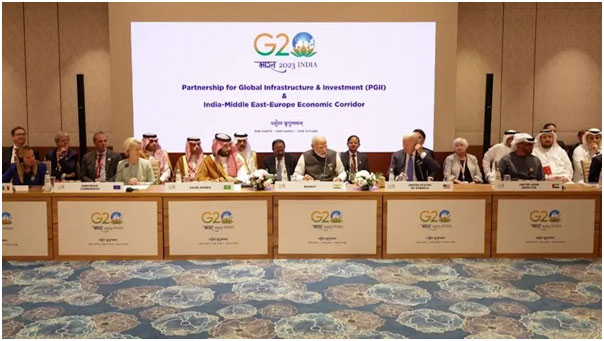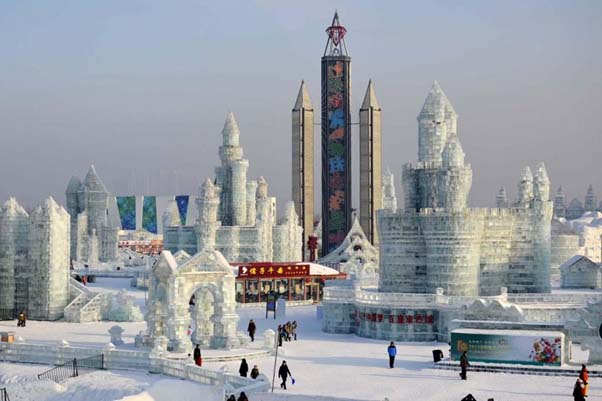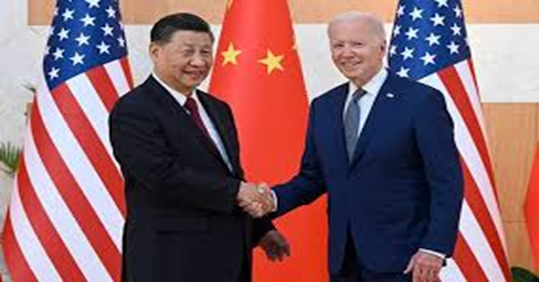India-Middle East-Europe Economic Corridor (IMEC): A Transformative Initiative Connecting Continents
Posted on : September 21, 2023Author : Abhishek Yadav

On September 9, 2023, at the G20 Leaders’ event on the Partnership for Global Infrastructure and Investment in New Delhi, leaders from India, the United States, Saudi Arabia, the United Arab Emirates, France, Germany, Italy and the European Union collectively announced a new economic corridor, namely India-Middle East-Europe Economic Corridor (IMEC).[i] IMEC is an initiative under the Partnership for Global Infrastructure and Investment (PGII), launched in 2022 at the 48th G7 Summit in Germany. PGII represents a joint endeavour involving the G7 countries to finance infrastructure ventures in lowand middle-income nations.[ii] The PGII has been actively investing in a range of priority sectors, including tackling climate change and addressing the energy crisis, enhancing the resilience of supply chains, improving connectivity through digital infrastructure and transportation networks, building sustainable healthcare systems, and promoting gender equality and equity.
After the signing of bilateral agreements under the Abraham Accords in 2020 for Arab-Israeli normalisation, prioritisation towards connectivity and regional integration has increased. Thereafter, the White House initiated discussions with regional allies regarding the IMEC and the creation of maps and written evaluations of the current rail infrastructure in the Middle East started.[iii] In May 2023, National Security Advisors of the USA, India, and the UAE held a meeting with the Saudi Prime Minister in Saudi Arabia to further their joint vision of creating a more secure and prosperous Middle East region closely connected with India and the rest of the world. Since then, all parties involved have diligently collaborated to iron out the agreement’s specifics.
Specifications of IMEC
According to the MoU, the IMEC will consist of two distinct corridors: the eastern corridor, which will link India with the Gulf, and the northern corridor, connecting the Gulf to Europe. It will incorporate a railway network that, once entirely constructed, will establish a dependable and cost-efficient cross-border ship-to-rail transport network. This network will complement the existing maritime and road transportation routes, facilitating the seamless transit of goods and services among India, the UAE, Saudi Arabia, Jordan, Israel, and Europe.[iv]
MoU also specifies that along the railway route, the involved parties aim to facilitate laying cables for electricity and digital connectivity and pipelines for exporting clean hydrogen. It has also been specified that the corridor will enhance regional supply chains, boost trade accessibility, improve trade facilitation, and underscore a heightened focus on environmental, social, and government impacts.[v]
Potential Benefits of IMEC
Indian Prime Minister Narendra Modi stressed the project’s importance, foreseeing it as a beacon of cooperation, innovation, and shared progress for India, West Asia, and Europe. Modi also highlighted the project’s significance for connectivity, leading to mutual trade and trust. US President Joe Biden highlighted the corridor’s role in facilitating trade and energy exports. Referring to the cables for transmitting data and electricity, Ursula Von der Leyen, President of the European Commission, described IMEC as a “green and digital bridge across continents and civilisations.” Saudi Crown Prince Mohammed bin Salman expressed confidence that the project would contribute to developing railway networks, infrastructure, and long-term business opportunities.
According to the White House Statement[vi], this envisioned corridor is anticipated to foster economic progress by improving connectivity and economic integration across continents, paving the way for sustainable and inclusive economic growth. Participant countries aspire to establish links through commercial hubs to facilitate the development and export of clean energy. They plan to lay undersea cables and connect energy grids and telecommunication lines to expand access to reliable electricity. IMEC also seeks to foster innovation in advanced clean energy technologies and ensure secure and stable Internet access for communities. It envisions boosting existing trade and manufacturing activities while enhancing the corridor’s food security and supply chains. The approach is designed to attract new investments from various partners, including the private sector, and stimulate the creation of high-quality jobs.
The National Security Strategy of the US was published in October 2022, and it clearly outlined the envisioned role of the US in the Middle East to strive for regional integration through fostering economic, political and security ties among its partner nations. Through the IMEC, the US also seeks to enhance its deteriorating clout in the Middle East, thereby challenging China’s presence. From a Gulf point of view, the new undertaking will reinforce the region’s longstanding role as the leading trade pathway connecting Asia, Europe, and Africa. By focusing on energy trade, the initiative is capitalising on the Gulf’s comparative advantage to offer affordable energy to the global market.[vii] The eight IMEC signatory countries represent roughly 50% of the world’s economy and 40% of its population. Consequently, they possess the potential to significantly influence global trade and development if they are willing to allocate the necessary resources.[viii]
For India, it is a transformative opportunity to diversify its connectivity routes. The projected 40 per cent reduction in trade time between India and Europe[ix] is a substantial benefit that can significantly enhance the efficiency of commerce and boost economic integration between these two regions. This time-saving factor alone can make IMEC a highly attractive proposition for businesses and governments alike. In essence, it can be argued that the participant countries have the aspiration that the corridor will bring about greater efficiencies, cost reduction, enhanced economic cohesion, job creation, and reduced greenhouse gas emissions. IMEC seeks a transformative integration of Asia, Europe, and the Middle East.[x]
Potential Alternative for China’s BRI?
The timing of the announcement of the MoU on IMEC also holds immense significance, especially when China will organise the third BRI conference in October 2023. China is celebrating the 10th anniversary of the BRI by organising this conference titled Belt and Road Forum for International Cooperation (BRF) in Beijing. China has claimed the confirmed participation from 90 countries.[xi] The IMEC announcement indicates a geopolitical and geo-economic competition between the US and China, both vying for influence in the same regions.
With regards to IMEC, China’s Global Times is of the view that there are underlying geopolitical motivations behind this project. The US is aiming to diminish China’s sway in the Middle East and neighbouring areas by constructing extensive economic pathways as a strategic response to the Belt and Road Initiative (BRI).[xii] Terming IMEC as a political instrument, China has argued that the execution of this project is still uncertain and in line with a pattern of many US strategic initiatives. For China, this scepticism arises from the project’s significant political implications, raising concerns about the authenticity of Washington’s offer of infrastructure assistance to developing nations.[xiii]
It is interesting to note that Italy has already signalled to withdraw from BRI. Italy signed a five-year MoU with China in 2019 that needs renewal in March 2024. One of the core goals of the MoU was to address this trade imbalance, but after four years, there has been little to no significant change in the situation. Italy’s exports to China have seen a relatively small rise, going from 14.5 billion euros in 2019 to 18.5 billion euros in 2022. In contrast, Chinese exports to Italy have surged from 33.5 billion euros to 50.9 billion euros during the same timeframe.[xiv] It has resulted in Italy consistently having a substantial trade deficit with China. Italy’s decision to signal its intention to withdraw from BRI underscores the challenges China faces in maintaining the enthusiasm of its partners in long-term projects. Many reports are already providing insights into China’s ‘debt-trap diplomacy’. The trade imbalances and economic concerns associated with BRI have made Italy reassess its involvement, setting a precedent for other nations to reevaluate their participation in Chinese-led initiatives.
IMEC’s emergence highlights the evolving landscape of global infrastructure diplomacy and increasing competition among major powers for influence through such projects. It also serves as a reminder that the success of these initiatives will depend not only on their economic viability but also on their collective ability to address mutual concerns and foster genuine cooperation among participating nations.
Conclusion
IMEC represents an ambitious venture with the potential to reshape not only the economic landscape but also the geopolitical dynamics of the regions it spans. With the participation of major economies and key players like India, the United States, Gulf countries and European nations, IMEC promises to foster enhanced connectivity, trade, and sustainable development. In the context of the Middle East, IMEC offers the opportunity for a positive-sum game. It presents a chance for the Gulf countries to diversify their existing infrastructure and trade routes, providing an alternative option to enhance their economic growth and regional influence.
While IMEC proposes a potentially more transparent approach to infrastructure development than China’s BRI, it doesn’t necessarily need to be viewed as a zero-sum competition. Instead, it can be seen as a constructive force that benefits multiple stakeholders in the Middle East, contributing to the region’s overall prosperity. The US is actively involved in IMEC to support its broader strategic goals, including fostering regional integration and economic growth, countering potential competitors, and strengthening alliances in these vital regions.
Participant countries of IMEC have agreed to prepare an action plan with set timelines within two months, showcasing their paramount priority. However, it is yet to be seen what will be the financial share of each founding member to complete the proposed project. The challenges for IMEC are complex. These include managing logistics and supply chain issues, ensuring smooth implementation across continents to compete with established maritime routes and handling geopolitical tensions diplomatically. Success depends on effectively addressing these challenges while realising its economic and geopolitical potential. The coming years will reveal whether IMEC can fulfil its aspirations and how it will shape the future of trade, connectivity, and global influence.
Abhishek Yadav is a Research Analyst at the Manohar Parrikar Institute for Defence Studies and Analyses (MP-IDSA).
[i]“Fact Sheet: World Leaders Launch a Landmark India-Middle East-Europe Economic Corridor”, The White House, 9 September 2023. URL: https://www.whitehouse.gov/briefing-room/statements-releases/2023/09/09/fact-sheet-world-leaders-launch-a-landmark-india-middle-east-europe-economic-corridor/
[ii] “Fact Sheet: Partnership for Global Infrastructure and Investment at the G7 Summit”, The White House, 20 May 2023. URL: https://www.whitehouse.gov/briefing-room/statements-releases/2023/05/20/fact-sheet-partnership-for-global-infrastructure-and-investment-at-the-g7-summit/
[iii] “Biden, Modi announce economic corridor linking India to Middle East, Europe at G20”, Public Broadcasting Service, 9 September 2023. URL: https://www.pbs.org/newshour/world/watch-biden-modi-announce-economic-corridor-linking-india-to-middle-east-europe-at-g20
[iv]“Memorandum of Understanding on the Principles of an India-Middle East-Europe Economic Corridor”,The White House, 9 September 2023. URL: https://www.whitehouse.gov/wp-content/uploads/2023/09/Project-Gateway-Multilateral-MOU.pdf
[v] Ibid.
[vi]“Fact Sheet: World Leaders Launch a Landmark India-Middle East-Europe Economic Corridor”, The White House, 9 September 2023. URL: https://www.whitehouse.gov/briefing-room/statements-releases/2023/09/09/fact-sheet-world-leaders-launch-a-landmark-india-middle-east-europe-economic-corridor/
[vii]Abdel Aziz Aluwaisheg, “The far-reaching implications of the India-Middle East-Europe Economic Corridor”, Arab News, 12 September 2023. URL: https://www.arabnews.com/node/2372351
[viii] Ibid.
[ix] “G20 summit: Transport project to link India to Middle East, Europe unveiled”, Al Jazeera, 9 September 2023. URL: https://www.aljazeera.com/news/2023/9/9/g20-summit-transport-project-to-link-india-to-middle-east-europe-unveiled
[x]“Memorandum of Understanding on the Principles of an India-Middle East-Europe Economic Corridor”,The White House, 9 September 2023. URL: https://www.whitehouse.gov/wp-content/uploads/2023/09/Project-Gateway-Multilateral-MOU.pdf
[xi] “China says 90 countries have confirmed attendance for Belt and Road Initiative”, Reuters, 7 September 2023. URL: https://www.reuters.com/world/china-says-90-countries-have-confirmed-attendance-belt-road-initiative-2023-09-07/
[xii]“GT Voice: Grand US rail plan might be another road going to nowhere”, Global Times, 11 September 2023. URL: https://www.globaltimes.cn/page/202309/1297999.shtml
[xiii] Ibid.
[xiv] Gabriele Manca, “Italy’s BRI Dilemma”, Italian Institute for International Political Studies, 27 July 2023. URL: https://www.ispionline.it/en/publication/italys-bri-dilemma-137315
The originality of the content and the opinions expressed within the content are solely the author’s and do not reflect the opinions and beliefs of the website.




